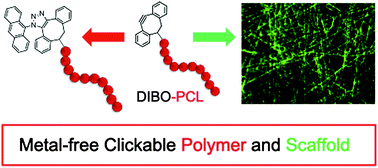Nanofibrous scaffolds possessing mechanical properties, porous microstructure, and dimensional similarity to collagen fibers have been used to mimic the natural extracellular matrix (ECM) and are highly relevant for tissue engineering in a number of different applications. Polymeric nanofibers have been fabricated into a variety of constructs and scaffolds using melt- or electrospinning processes. For regenerative medicine applications, the polymeric precursors used to fabricate the nanofiber-based scaffolds should be both biocompatible and biodegradable. Many biodegradable and biocompatible polymers have been widely investigated as fiber and nanofiber precursor materials. Although these degradable polymers meet several of the basic requirements for tissue engineering applications, bioactive molecules to guide cellular behavior and preserve cell phenotype are required for optimal performance.
In this context, Becker and co-workers described a polymerization method utilizing 4-dibenzocyclooctynol (DIBO) as an initiator for the ring-opening polymerization of 3-caprolactone which yielded an end-functionalized PCL polymer. The DIBO group survived the relatively mild polymerization conditions and offered efficient, orthogonal and biocompatible functionalization opportunities for both the polymer and polymer-derivatized biomaterials. The combination of PCL and DIBO enabled large-scale production of a new type of easily functionalizable nanofiber-based scaffold with versatile regenerative medicine applications.
4-Dibenzocyclooctynol (DIBO) as an initiator for poly(ε-caprolactone): copper-free clickable polymer and nanofiber-based scaffolds by Laurent Chabanne, Stefan Pfirrmann, David J. Lunn and Ian Manners, Polym. Chem., 2013, 4, 2215-2218.
Julien Nicolas is a guest web-writer for Polymer Chemistry. He currently works at Univ. Paris-Sud (FR) as a CNRS researcher.











